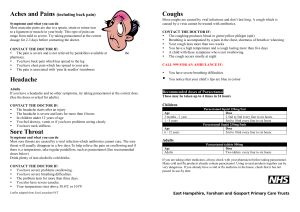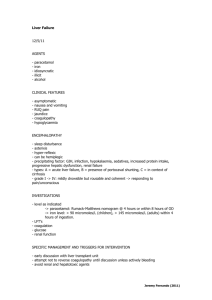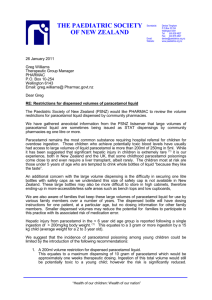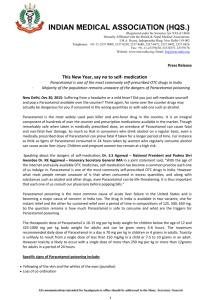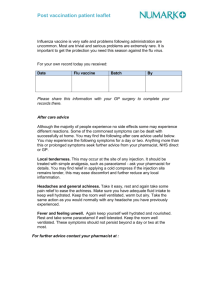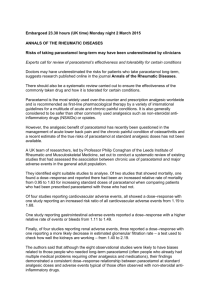הודעה על החמרה ( מידע בטיחות) בעלון לצרכן
advertisement
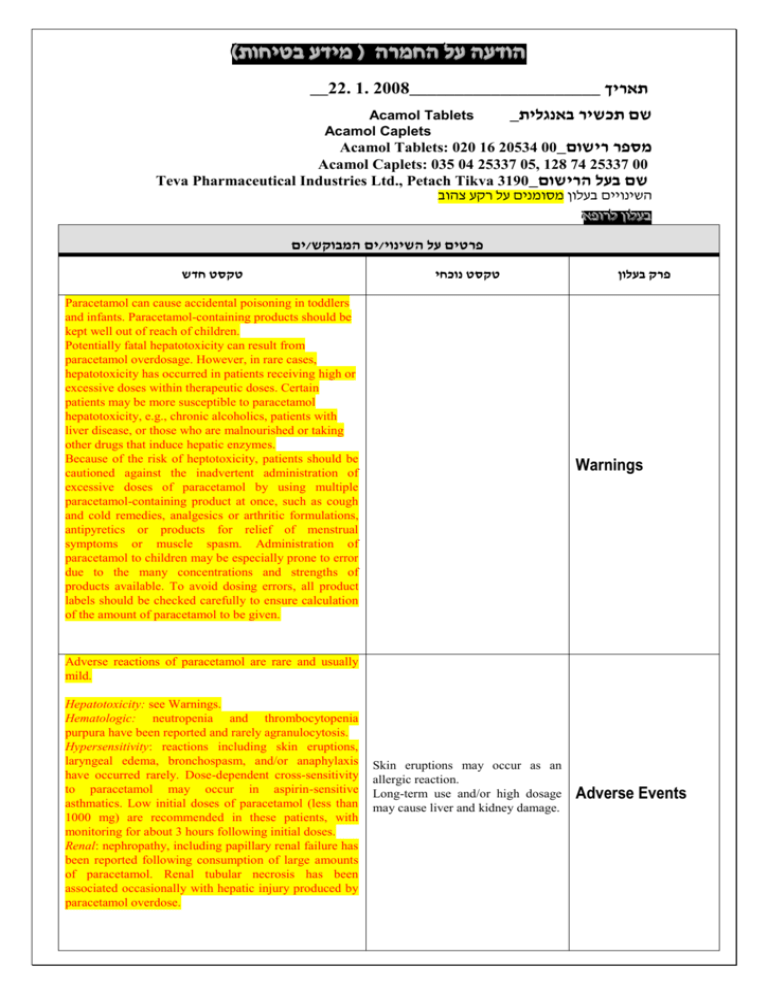
)בטיחות )מידע בטיחות החמרה (( מידע על החמרה הודעה על הודעה __22. 1. 2008_____________________ תאריך Acamol Tablets Acamol Caplets _שם תכשיר באנגלית Acamol Tablets: 020 16 20534 00_מספר רישום Acamol Caplets: 035 04 25337 05, 128 74 25337 00 Teva Pharmaceutical Industries Ltd., Petach Tikva 3190_שם בעל הרישום השינויים בעלון מסומנים על רקע צהוב רופא בעלון ללרופא בעלון ים/ים המבוקש/פרטים על השינוי טקסט חדש טקסט נוכחי Paracetamol can cause accidental poisoning in toddlers and infants. Paracetamol-containing products should be kept well out of reach of children. Potentially fatal hepatotoxicity can result from paracetamol overdosage. However, in rare cases, hepatotoxicity has occurred in patients receiving high or excessive doses within therapeutic doses. Certain patients may be more susceptible to paracetamol hepatotoxicity, e.g., chronic alcoholics, patients with liver disease, or those who are malnourished or taking other drugs that induce hepatic enzymes. Because of the risk of heptotoxicity, patients should be cautioned against the inadvertent administration of excessive doses of paracetamol by using multiple paracetamol-containing product at once, such as cough and cold remedies, analgesics or arthritic formulations, antipyretics or products for relief of menstrual symptoms or muscle spasm. Administration of paracetamol to children may be especially prone to error due to the many concentrations and strengths of products available. To avoid dosing errors, all product labels should be checked carefully to ensure calculation of the amount of paracetamol to be given. פרק בעלון Warnings Adverse reactions of paracetamol are rare and usually mild. Hepatotoxicity: see Warnings. Hematologic: neutropenia and thrombocytopenia purpura have been reported and rarely agranulocytosis. Hypersensitivity: reactions including skin eruptions, laryngeal edema, bronchospasm, and/or anaphylaxis have occurred rarely. Dose-dependent cross-sensitivity to paracetamol may occur in aspirin-sensitive asthmatics. Low initial doses of paracetamol (less than 1000 mg) are recommended in these patients, with monitoring for about 3 hours following initial doses. Renal: nephropathy, including papillary renal failure has been reported following consumption of large amounts of paracetamol. Renal tubular necrosis has been associated occasionally with hepatic injury produced by paracetamol overdose. Skin eruptions may occur as an allergic reaction. Long-term use and/or high dosage may cause liver and kidney damage. Adverse Events Adverse reactions of paracetamol are usually mild, though hematological reactions have been reported in rare cases. Skin eruptions may occur as an allergic reaction. Long-term use and/or high dosage may cause liver and kidney damage. Paracetamol/Oral Anticoagulants: Regular administration of paracetamol may enhance the activity of coumarin anticoagulants when given concurrently. Occasional doses have no significant effect. Paracetamol/Hepatic Enzyme-Inducing Agents (e.g.: Barbiturates, Phenytoin)/ Carbamazepine, Hepatotoxic Medications/ Alcohol: Concurrent administration of enzyme inducers and paracetamol may decrease the therapeutic effect of paracetamol, probably because of increased metabolism resulting from induction of hepatic microsomal enzyme activity. The risk of hepatotoxicity with single toxic doses or prolonged use of high doses of paracetamol may be increased in patients consuming alcoholic beverages or in patients taking other hepatotoxic medications. Paracetamol/ Salicylates/ Other Non-Steroidal AntiInflammatory Drugs (NSAIDs): Chronic high-dose administration of paracetamol with salicylates and/or other non-steroidal anti-inflammatory drugs increases the risk of analgesic nephropathy. Paracetamol/ Zidovudine: Paracetamol may competitively inhibit the hepatic glucuronidation and decrease the clearance of zidovudine. Zidovudine may also inhibit the hepatic glucuronidation of paracetamol. Concurrent use should be avoided, because the toxicity of either or both medications may be potentiated. Paracetamol/Cholestyramine: Cholestyramine may reduce the absorption of paracetamol. Oral doses of cholestyramine and paracetamol should be given at least 1 hour apart. Paracetamol/Metoclopramide/Domperidone: The speed of absorption of paracetamol may be increased by metoclopramide or domperidone. Paracetamol/Oral Anticoagulants: Regular administration of paracetamol may enhance the activity of coumarin anticoagulants when given concurrently. Occasional doses have no significant effect. Paracetamol/Hepatic EnzymeInducing Agents (e.g.: Barbiturates, Phenytoin)/ Hepatotoxic Medications/ Alcohol: Concurrent administration of enzyme inducers and paracetamol may decrease the therapeutic effect of paracetamol, probably because of increased metabolism resulting from induction of hepatic microsomal enzyme activity. The risk of hepatotoxicity with single toxic doses or prolonged use of high doses of paracetamol may be increased in patients consuming alcoholic beverages or in patients taking other hepatotoxic medications. Paracetamol/ Salicylates/ Other Non-Steroidal Anti-Inflammatory Drugs (NSAIDs): Chronic highdose administration of paracetamol with salicylates and/or other nonsteroidal anti-inflammatory drugs increases the risk of analgesic nephropathy. Paracetamol/ Zidovudine: Paracetamol may competitively inhibit the hepatic glucuronidation and decrease the clearance of zidovudine. Zidovudine may also inhibit the hepatic glucuronidation of paracetamol. Concurrent use should be avoided, because the toxicity of either or both medications may be potentiated. Drug Interactions Precautions Manifestations Symptoms of paracetamol overdosage in the first 24 hours are pallor, nausea, vomiting, anorexia, and abdominal pain. Abnormalities of glucose metabolism and metabolic acidosis may occur. In severe poisoning, hepatic failure may progress to encephalopathy, coma and death. Acute renal failure with acute tubular necrosis may develop even in the absence of severe liver damage. Cardiac arrhythmias and pancreatitis have been reported. In massive overdosage, paracetamol may cause hepatic toxicity. In adults and adolescents, hepatic toxicity has been rarely reported following ingestion of acute overdose of less than 7.5 –10 g. Fatalities are infrequent (less than 3-4% of untreated cases) and have been rarely reported with overdoses of less than 15 g. Early symptoms following a potentially hepatotoxic overdose may include nausea, vomiting, stomach pain, diaphoresis, and general malaise. Clinical and laboratory evidence of hepatic toxicity may not be apparent until 48-72 hours post-ingestion. Serious toxicity or fatalities are extremely infrequent in children, possibly due to differences in the way they metabolize paracetamol. An acute overdosage of less than 150 mg/kg bodyweight in children has not been associated with hepatic toxicity. In massive overdosage, paracetamol may cause hepatic toxicity. In adults and adolescents, hepatic toxicity has been rarely reported following ingestion of acute overdose of less than 7.5 –10 g. Fatalities are infrequent (less than 3-4% of untreated cases) and have been rarely reported with overdoses of less than 15 g. Early symptoms following a potentially hepatotoxic overdose may include nausea, vomiting, stomach pain, diaphoresis, and general malaise. Clinical and laboratory evidence of hepatic toxicity may not be apparent until 48-72 hours post-ingestion. Serious toxicity or fatalities are extremely infrequent in children, possibly due to differences in the way they metabolize paracetamol. An acute overdosage of less than 150 mg/kg bodyweight in children has not been associated with hepatic toxicity Overdosage

